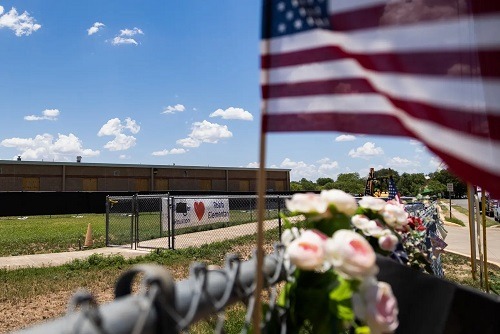
7.17.22 – TEXAS TRIBUNE STAFF
Among the findings: Police lacked clear leadership and basic communications, school doors were routinely left open and the gunman gave hints of his coming rampage.
A report released Sunday by a special committee of the Texas House provides the most thorough account yet of the May 24 Uvalde school shooting and the failures of law enforcement and other state and local officials. In 77 pages, it described how the shooter prepared and armed himself, how the school district fell short on campus safety preparations and how law enforcement moved too slowly to end a massacre that left 19 students and two teachers dead.
Here are five takeaways:
1. Law enforcement failures go beyond local police:
In total, 376 law enforcement officers descended upon the school in a chaotic, uncoordinated scene that stretched for 73 more minutes. The group was devoid of clear leadership, basic communications and sufficient urgency to take down the gunman, the report says.
Instead of following the active shooter doctrine developed after the 1999 Columbine High School massacre, which dictates that officers immediately confront active shooters, police at Robb Elementary retreated after coming under fire and then waited for backup.
Prior investigations have pointed the finger at Uvalde schools police Chief Pete Arredondo for failing to take over command of the scene and waiting for a key to unlock the door to the classroom where the shooter had holed up. But the reports note that no state police nor federal agents, who vastly outnumbered Uvalde school and city police, asked Arredondo if he could cede authority over the response.
REFERENCE
A Texas House committee’s report on the Robb Elementary School shooting in Uvalde.
(9.9 MB) DOWNLOAD
2. The school’s safety protocols fell short:
Robb Elementary’s active shooter policy called for doors to classrooms to be locked during school hours. But multiple witnesses told the committee that employees often left doors unlocked, while teachers would use rocks, wedges and magnets to prop open interior and exterior doors. This was partly because of a shortage of keys, the report states.
The door to Room 111, one of the two adjoining classrooms where the attacker did most of the shooting, was reported in March to not always lock. But the head custodian testified he never heard of any problems with that door, and maintenance records during the school year do not contain any work orders for it.
In addition, Uvalde schools used an alert system that included a phone application allowing anyone in the school to initiate a “secure” or “lockdown” alert. But the committee found that staff did not reliably receive the alerts — due in part to poor Wi-Fi and cell coverage and the fact that some school personnel didn’t keep their phones on or carry them with them. The committee also found that school personnel didn’t always respond to alerts with a sense of urgency.
3. “Bailouts” desensitized school personnel to safety alerts:
One reason for a culture of complacency around alerts is that they happened so often. Uvalde is located about an hour from the U.S.-Mexico border and police described an increase in “bailouts” near the school, in which officers chase a vehicle containing suspected undocumented migrants who then purposely crash and scatter to avoid apprehension.
Since late February, there were 47 “secure” or “lockdown” events at Uvalde schools, according to the report. Around 90% of them were attributed to bailouts, the committee said.
“Uvalde CISD parents became so concerned about the number of bailouts occurring near the elementary-school campuses that they offered to hire off-duty police to supplement the Uvalde CISD police presence,” the report said.
4. The shooter gave hints of his coming rampage:
On April 2, the shooter sent someone a direct message on Instagram: “Are you still gonna remember me in 50 something days?”
The person responded, “probably not.”
“Hmm alright we’ll see in may,” he replied.
That was one of several cryptic hints the gunman gave online that he was planning something. Online, officials said, he started to show an interest in gore and violent sex, sometimes sharing videos and images of suicides and beheadings. While playing games, he became enraged and threatened others, especially female players, when he lost.
Attacking women became a pattern. He was also fired from his job at a Whataburger after a month for threatening a female coworker.
But despite the threats and violent talk, none of his online behavior was reported to law enforcement. It’s unclear whether other users reported his behavior to any social media platform, but the committee concluded it doesn’t appear there were any actions taken to restrict his access or to report him to authorities as a threat.
5. Officials didn’t have their facts straight in the aftermath of the shooting:
In the days following the shooting, state officials unnecessarily undermined public trust in the ongoing investigations by making false statements about what had happened, the report states.
The day after the massacre, a Uvalde Police Department lieutenant tasked with briefing Gov. Greg Abbott and other state leaders fainted just before the meeting began. DPS Regional Director Victor Escalon took his place, relaying the secondhand accounts of police, as he had arrived at the school minutes before the shooting ended.
Some of this information was inaccurate, which the committee said was the reason Abbott, in a news conference immediately following the briefing, presented a “false narrative” that the shooting lasted as few as 40 minutes thanks to “officers who rapidly devised a plan, stacked up and neutralized the attacker.”
“A complete and thorough investigation can take months or even years to confirm every detail, especially when this many law enforcement officers are involved,” the report states. “However, one would expect law enforcement during a briefing would be very careful to state what facts are verifiable, and which ones are not.”
Staff writers Zach Despart, Perla Trevizo and Matthew Watkins contributed to this report.
